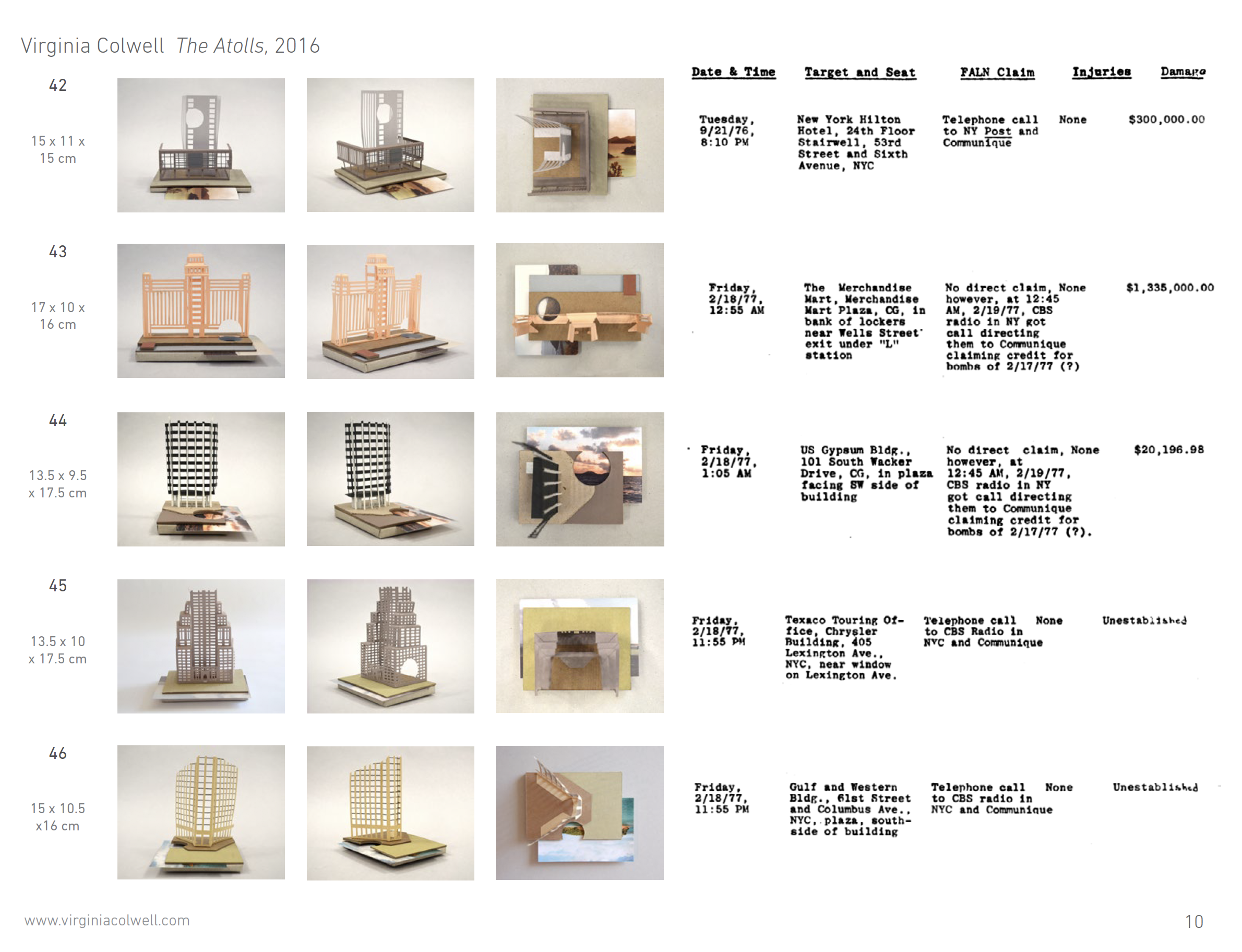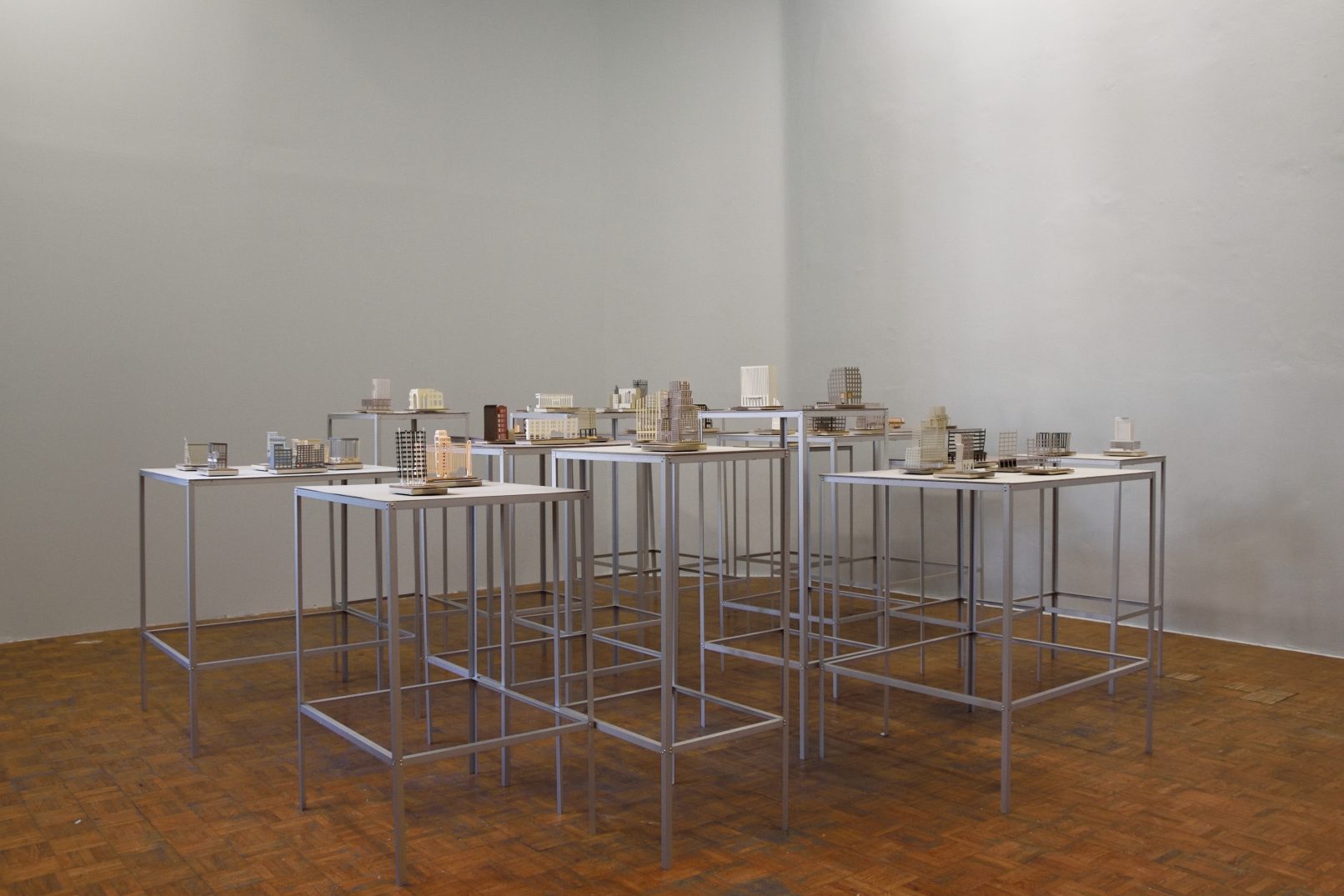THE ATOLLS
Paper maquettes, 2016
This work is part of my series on the history of the FALN.
Before any of the members of the FALN were captured, the public face and voice of the group was represented by their bombing campaign and the communiqués that accompanied those bombs. For my Atolls project I analyzed, corroborated, mapped, and documented their bombing strategy using two sources: Toward a People’s War, a booklet published by a group in solidarity with the FALN; and the police report, FALN Perpetrated Bombing and Incendiary Incidents. The Atolls creates an out-of-scale geography of the FALN’s revolutionary actions, a partial portrait of the group that attempts to transform the explosives that they laid at the foundations of corporate headquarters and government buildings into something tangible.
I have always been fascinated by the scale-models of historical sites that are common in history museums, as you stand over one of those miniatures you start to believe that you can see the entirety of a historical place. When you can see something as a whole, even if it is a miniaturized version of some past event that has left no trace, you feel a sense of understanding the past or at least understand its terrain. With The Atolls I wanted to challenge the abstract representation of history through the scale model. In my model the terrain of the FALN’s actions is confused and the maquettes, like much of the group’s history, represent the past in a manner that is fragmented, out of perspective, and simplified through fragile paper constructions.
The Atolls is a series of forty five fragmented, fragile paper models. Each model represents a building bombed by the FALN in New York, Washington, and Chicago in the 1970s. Largely a forgotten history, the FALN and their bombing campaign for Puerto Rican independence intrigued Colwell and provoked her to question how to represent a forgotten past and to question why such a past has been forgotten.
Beneath each model is a photograph of a Caribbean island, taken on family vacations by my father when I was a child. The family photographs show unambiguously to how Puerto Rico is principally imagined and consumed by Americans: as a haven for tropical leisure and tourism. This perspective, whitewashed of the island’s colonial vestiges or any ongoing social conflict, was precisely the perspective that the FALN was trying to rupture with each bomb.
The work represents the first forty six of the more than one hundred bombings attributed to the FALN. In addition, I feel that it deserves mentioning that the FALN bombs had a huge variety: everything from the strong lethal explosions that we typically associate with bombing campaigns to Ping-Pong ball incendiaries which, like many of their bombs, never went off. In my maquettes I represent all of these equally. In other words, it is not the bombs per se that are represented but rather the site of each political action.
The Atolls, 2016.
Paper, compressed cardboard, book cloth, and photographs.
Dimensions variable.
Maquetas de papel 2016.
Este trabajo es parte de mi serie sobre la historia de las FALN.
Antes de que cualquier miembro de las FALN fuese capturado, la cara y voz pública del grupo eran representadas por su campaña de bombardeo y los comunicados que acompañaban esas bombas. Para mi proyecto Los atolones analicé, corroboré, mapeé, y documenté su estrategia de bombardeo usando dos fuentes: Toward a People’s War (Hacia una guerra del pueblo), un librillo publicado por un grupo en solidaridad con las FALN; y un reporte policial, List of FALN Perpetrated Bombing and Incendiary Incidents (Lista de los bombardeos perpetrados por las FALN e incidentes incendiarios). Los atolones crea una geografía a escala de las acciones revolucionarias de las FALN, un retrato parcial del grupo, que atenta transformar en algo tangible los explosivos que ellas pusieron en los cimientos de las oficinas centrales de edificios corporativos y gubernamentales.
Siempre me han fascinado los modelos a escala de sitios históricos que comúnmente se encuentran en los museos de historia, pues mientras estás frente a esas miniaturas comienzas a creer que puedes ver la totalidad de un lugar histórico. Cuando puedes ver algo como un todo, incluso si es una versión miniaturizada de algún evento pasado que no ha dejado rastro, adquieres un sentido de comprensión del pasado o al menos de entendimiento de su terreno. Con Los atolones yo quería retar la representación abstracta de la historia por vía de un modelo a escala. En mi modelo, el territorio de las acciones de las FALN es confuso y las maquetas, como mucho de la historia del grupo, representan al pasado de un modo fragmentado, fuera de perspectiva, y simplificado a través de construcciones de papel frágiles.
Debajo de cada maqueta yace una fotografía de una isla. Estas imágenes, tomadas por mi familia mientras viajamos por el Caribe, hacen un eco de la isla colonial sobre la cual las FALN esperaban llamar la atención con cada bomba. De modo inverso, esas fotografías también señalan directamente el cómo, en general, los estadounidenses imaginan y consumen la isla: un refugio para el ocio tropical y el turismo, con sus vestigios coloniales y cualquier tipo de conflicto social maquillados.
El trabajo representa los primeros cuarenta y seis de más de cien bombardeos atribuidos a las FALN. En adición, siento que merece ser mencionado que las bombas de las FALN fueron de una gran variedad: desde las explosiones letales que típicamente asociamos con las campañas de bombardeo hasta las bombas incendiarias de bolas de ping-pong que, como muchas de sus bombas, nunca estallaron. En mis maquetas represento toda ello igualitariamente. En otras palabras, no son las bombas per se lo que está representado sino el sitio de cada acción política.
The Atolls, 2016.
Papel, cartón comprimido, tela de encuadernación, y fotografías.
Dimensiones variables.













